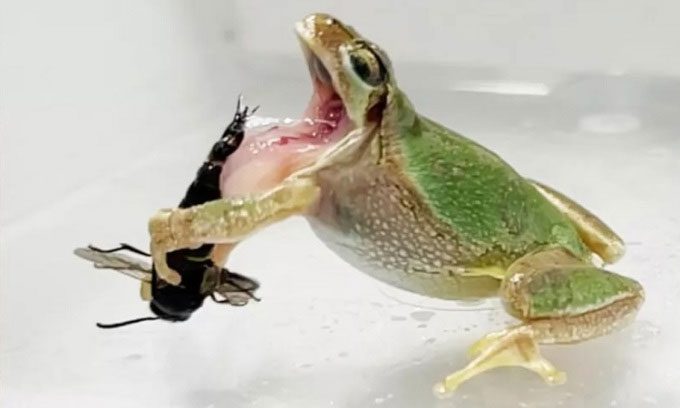Although male wasps lack the stinger found in females, male paper wasps use sharp spines on their genitalia to fend off predators and escape.
Only female wasps possess the necessary weaponry to sting prey and inject venom into their bodies, leading to the belief that male wasps are completely harmless. However, a study published on December 19 in the journal Current Biology reveals that male wasps can evade danger by utilizing their non-venomous but extremely sharp genital spines.

A tree frog releasing a male wasp after being stabbed. (Photo: Shinji Sugiura)
The two slender spines are retractable and located on either side of the genitalia of the male paper wasp (Anterhynchium gibbifrons). While some wasp species use their spines to hold onto females during mating, male paper wasps do not seem to do this, at least in a laboratory setting. Instead, they expose their spiny genitalia only when confronted with a threatening object, such as a scientist’s hand.
Misaki Tsujii, a co-author of the study and a graduate student at the Graduate School of Agricultural Science at Kobe University in Japan, was studying the life cycle of paper wasps when she suddenly felt a sharp pain in her finger. She was working with a seemingly harmless male wasp and was taken aback by the incident.
Tsujii and her colleague Shinji Sugiura, an associate professor at the same university, designed an experiment to test whether male wasps could use their genitalia to ward off predators they might encounter in nature. They brought Japanese tree frogs (Dryophytes japonica) into the lab, placed them in a container with male paper wasps, set up a camera, and waited.
When a tree frog opened its mouth wide to capture a male wasp, the wasp responded by biting the frog and stabbing the predator with its genital spines. However, most of the wasp’s defensive efforts were ineffective; nearly 65% of the wasps were ultimately eaten. In the remaining 35.3% of cases, however, the tree frogs released the wasps, allowing them to fly away.
The researchers repeated the experiment with male wasps that had their genitalia removed, and these wasps were quickly devoured, even though they still bit the frogs with their jaws. Thus, they concluded that the genital spines play a crucial role in preventing tree frogs from swallowing male paper wasps.
The effectiveness of the genital spines in male wasps is significantly lower compared to the stings of female wasps. Tree frogs eat fewer female wasps and, when attacked, they spit out female wasps in approximately 87.5% of cases. The researchers also exposed both male and female wasps to a second predator, the black-spotted pond frog (Pelophylax nigromaculatus). However, this frog species was able to withstand the defensive mechanisms of both male and female wasps and quickly consumed them. According to Sugiura, pond frogs have a high tolerance to stings; they can even eat highly venomous large wasps. The research team suspects that many other species of male wasps also use spines on their genitalia for self-defense.


















































